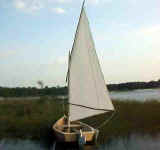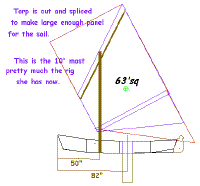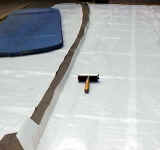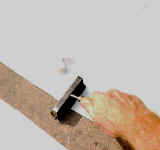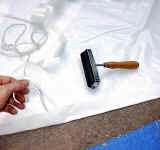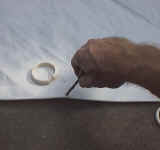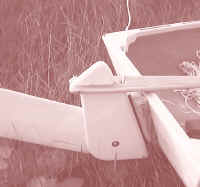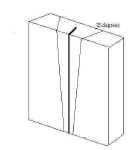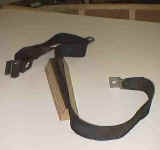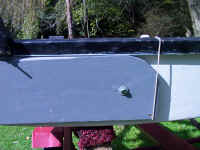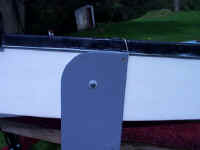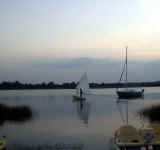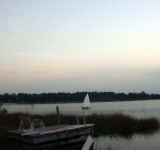Sailing bits, and polytarp sail making.
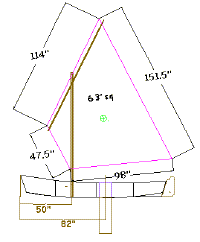
|
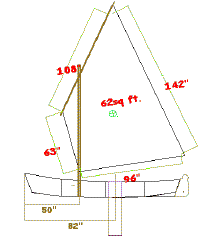 Here
are sketchs with side lengths. Here
are sketchs with side lengths. |
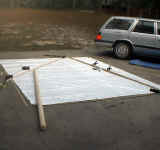
|
I marked the length of the sail's sides on wood strips and then did a trial layout. |
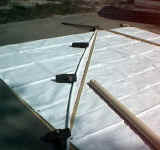
|
I use 3/4" PVC pipe to layout the curves of the sail edges. Here I'm drawing the shape of the head or top edge of the sail. This edge will be attached to the upper spar by rings or ties. I held the pipe in position with weights then traced its curve lightly. (Head or top of the sail curves out about 3 inches and the leech or trailing edge of the sail curves in about 2 inches.) If she needs more shape I'll try the little edge pleats that Dave Gray uses. As you might suspect, I try simpler first and get complicated only if necessary;-) |
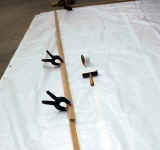 |
After tracing the pipe, I apply double stick fiberglass reinforced carpet tape on the outside of the line. An artist brayer helps apply it smoothly. |
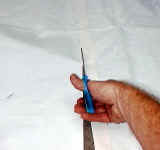
|
I then cut along the outer edge of the tape. (A foam pad or knee pads is handy for this part. You'll do a lot of crawling around.) | 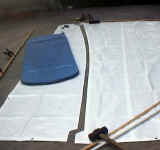
|
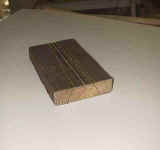
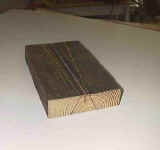 In this 10" piece of 2x6, I cut a 7/8" deep saw kerf down the center. The yellow dotted lines
shows how I taper the insert. In instrument building
this trick is used to join necks to bodies. When you insert it it will
snug it up against the transom. Way easier then hanging over the stern of a
small boat trying to line up pintels, I promise!
In this 10" piece of 2x6, I cut a 7/8" deep saw kerf down the center. The yellow dotted lines
shows how I taper the insert. In instrument building
this trick is used to join necks to bodies. When you insert it it will
snug it up against the transom. Way easier then hanging over the stern of a
small boat trying to line up pintels, I promise!
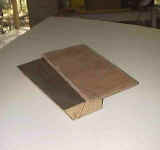
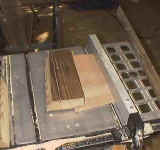 This could all be done with a hand
saw, but I used the table saw. I don't own a taper jig. But here's an easy way
to cut a taper using a scrap of plywood. I set the saw to 25 degrees and clamped
the fence about 5 inches away. I ran a scrap of plywood throught the saw. I then
lined the cut edge of the ply up with marks I made on the BOTTOM of the wedge
stock. I stapled it in place with 1/2" staples and ran in through the
saw. I then pulled it off and stapled it to the other line. Works great.
This could all be done with a hand
saw, but I used the table saw. I don't own a taper jig. But here's an easy way
to cut a taper using a scrap of plywood. I set the saw to 25 degrees and clamped
the fence about 5 inches away. I ran a scrap of plywood throught the saw. I then
lined the cut edge of the ply up with marks I made on the BOTTOM of the wedge
stock. I stapled it in place with 1/2" staples and ran in through the
saw. I then pulled it off and stapled it to the other line. Works great.
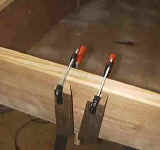 |
Here are the receivers trial clamped to the transom. |
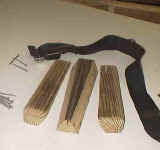
|
I shortened the receivers so the wedge is longer so I could tap it loose if it should get stuck. I've also rounded the edges and sanded them some. |
There is a simple 1/2" hole drilled in the top of the mast for the halyard. It is rounded with a 3/4" quarter round router bit. Just above the mast partner two wooden cleats are screwed on either edge of the mast. One is for the halyard and the other for the down haul.
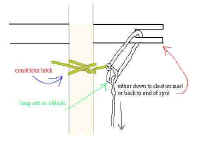 A simple snotter tensions the sprit
boom.
A simple snotter tensions the sprit
boom.
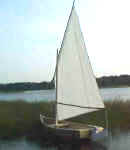
|
Here she is rigged, in the sprit boom version. |
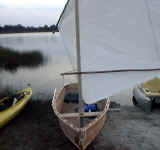
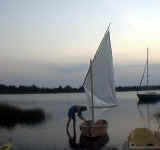 In spite of no wind I was determined to
sail.
In spite of no wind I was determined to
sail.
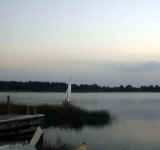
 We came back. The breeze was almost
theoretical it was so light, but she slipped along nicely. Since then I've had her
out in a few good breezes and according to my Garmin GPS we hit 7.5 knots quite
a few times. We must have
been planeing though I didn't feel it.
We came back. The breeze was almost
theoretical it was so light, but she slipped along nicely. Since then I've had her
out in a few good breezes and according to my Garmin GPS we hit 7.5 knots quite
a few times. We must have
been planeing though I didn't feel it.
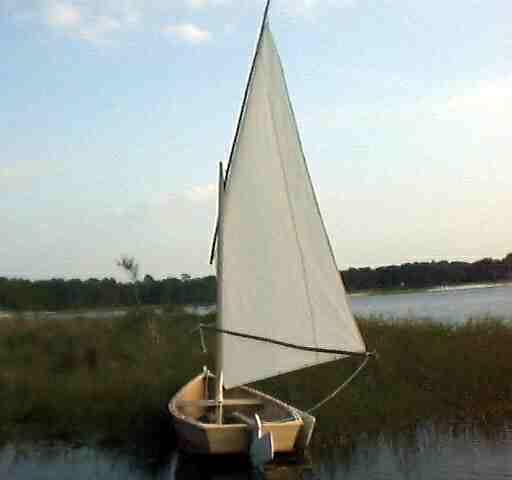 She
patiently awaits a captain...
She
patiently awaits a captain...
Shucks, if only I hadn't run out of time, I could have used that extra 8x10 polytarp for a camping cockpit tent!
